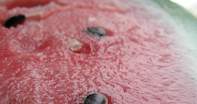Propagation
Watermelon propagation is from seed. Seeds can be direct seeded into the soil or seedlings can be made in seed trays and transplanted once the seedlings have grown.
Watermelon Planting Method
Plant watermelon seeds 30 to 40 mm deep. This is done by hand or by mechanical planter. Make sure soil is wet before planting and irrigate immediately after planting to settle seeds or seedlings.Spacing
Watermelon plants should be spaced 50 to 75 cm apart in rows that are 150 to 200 cm apart. Plant quantity varies between 8 000 and 15 000 plants per hectare depending on the watermelon variety, size and required use of the fruit.Sowing and Planting Time
Planting of watermelon seeds normally starts at the beginning of spring in late August through to December in South Africa. First plantings start when the weather starts warming up and most important when soil temperatures are above 15°C.
If soil temperatures are below this then uneven germination will occur resulting in uneven growth and in some cases seeds fail to germinate.
To speed up production for the early markets, some growers will make seedlings in greenhouses during July and be ready for the right conditions to plant the seedlings. This can give them a two to three week advantage on entering the market over the growers that direct seed.
Growth Period
The growing period is between 12 and 18 weeks depending on the cultivar and the weather conditions during the growing period. Smaller and seedless varieties of watermelon ripen quicker and are popular for catching the early market.Watermelon Fertilization
Fertilizer applications should be done according to the recommendations provided from the results of the soil analysis and the requirements of your crop. An indication of what is required for the watermelon crop is given here.
When ploughing in the green cover crop and compost about 5 weeks before planting spread 350 kg of superphosphate per hectare and plough this into the top 500 mm of soil at the same time. At the pre-plant stage, a few days prior to planting when the final soil tillage takes place, disk harrow about 800 kg of 2:3:4 (27) mixture per hectare into the top 20 cm of soil.
About three to four weeks after planting, once the plants have settled and are growing well, apply 300 to 400 kg of 1:0:1 (36) a mixture of Nitrogen (N) and Potassium (K) along the plant row and irrigate immediately. About 3 weeks after this a further 300 to 400 kg of 1:0:1 (36) can be applied to assist with fruit development and ripening. Irrigate immediately after each application of fertilizer.
Irrigation
Before planting irrigate the soil thoroughly to field capacity and maintain this so that the new seedlings can develop their roots quickly and utilise the nutrients that have been applied prior to planting. Monitor soil moisture stress regularly by hand with spade or augur or by soil moisture meters.
An average weekly irrigation is between 30 and 35 mm. This is normally divided into two or even three applications per week while the plants develop. As the fruit sets and the roots systems are more developed the frequency of irrigations can be reduced to once per week on the heavier loam soils.
As harvest nears irrigation should be reduced and in the last week before harvest can be stopped entirely unless temperatures are very high with relative humidity low.
By Louise Brodie